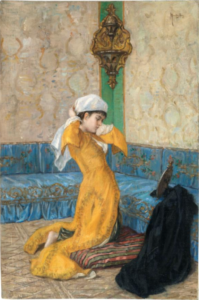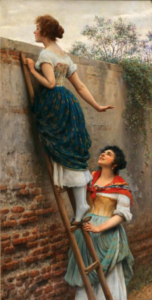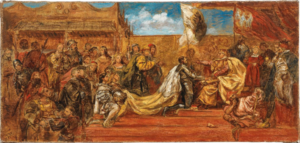
Ottoman lady, preparing for an outing by Osman Hamdi Bey
I normally don’t cover sales from continental European auction houses. However, when I saw the results from Dorotheum’s sale of nineteenth-century paintings, I knew I had to write something about it. On May 2nd, Dorotheum’s Vienna saleroom offered one hundred ninety-four lots, mainly by nineteenth-century European masters like Franz von Defregger, Marco Grubas, and Alfred Zoff. What made the sale noteworthy was not only how it did overall, but how much some of the lots exceeded their estimates by (w/p = with buyer's premium). The top lot of the sale fared exactly how the specialists predicted: Ottoman lady, preparing for an outing by Osman Hamdi Bey. The work shows an Ottoman interior scene, with a woman in a yellow robe putting on her headscarf. The painting, probably created sometime in the 1880s, is an example of Hamdi Bey’s interest in contemporary Ottoman fashion, as the details of the subject’s attire say a lot about her. The dress's color indicates she comes from a wealthy background since yellow dyes were rather expensive. The embroidered blue velvet on the sofa is in the style of Bursa artisans, while the cushions are made from silk. Paintings like this are similar to European works by Orientalist artists like Jean-Léon Gérôme and Eugène Delacroix. Though Western European painters often visited the Middle East and North Africa in their search for subjects, local customs often prohibited them from certain spaces. A woman’s living quarters were among these forbidden places, meaning that Hamdi Bey’s interior scenes, like the one sold on Tuesday at Dorotheum, fill in a lot of the gaps left by the European Orientalist painters, as well as offering far less mystical or exotic views of daily life in the Ottoman Empire. Hamdi Bey’s Ottoman Lady sold for €1M / $1.1M (or €1.275M / $1.4M w/p), meeting its assigned minimum estimate.

The Curious by Eugen von Blaas
While Ottoman Lady fell within the specialists' estimate, the other top lots exponentially surpassed them. The works of Eugen von Blaas often show contemporary women in informal settings, their dress being significantly less ornate but at times more colorful than the ball gowns worn by the subjects of other artists. His painting The Curious shows two women taking turns scaling a ladder to peer over a tall brick wall. It is unknown what lies beyond the wall, leaving the viewer with the same curiosity that provoked the painting’s subjects in the first place. Expected to sell for no more than €160K, The Curious eventually sold for €400K / $439.9K (or €520K / $571.9K w/p), more than two-and-a-half times its high estimate. And finally, taking everyone by surprise, in third place was an unframed oil study attributed to the Polish artist Jan Matejko. The work is a study of Matejko’s colossal 13-by-26-foot historical scene Prussian Homage, which currently hangs in the Sukiennice Museum in Kraków. Like many of Matejko’s paintings, Prussian Homage shows an important event from Polish history where the Duke of Prussia swore allegiance to King Sigismund I of Poland in 1525. The study is far less populated than the final painting, but there is no doubt that they share the same subject. However, Dorotheum probably could not determine whether Matejko himself created the study or if it was a student or workshop assistant, as the auction catalogue can only “attribute” the work to the artist. Though nowhere near as massive as the final work, the study, measuring 14 by 29 inches, still captured much attention. In the end, the study for Prussian Homage sold for an incredible €230K / $252.9K (or €299K / $328.9K w/p), or over nineteen times the €12K high estimate.

Study of Prussian Homage attributed to Jan Matejko
The Dorotheum sale mainly stood out because of the number of lots that exponentially exceeded their estimate ranges. The Von Blaas painting and the Matejko study were certainly two of these, but there were many more. Towards the end of the auction, the landscape by the German painter Carl Millner Grazing Cows near an Alpine Lake came across the block. Millner was one of the nineteenth century's most popular German landscape painters, becoming well-known for his alpine landscapes in particular. Though estimated to sell for no more than €8K, Grazing Cows eventually sold for three times as much at €24K / $26.4K (or €33.9K / $37.3K w/p). A little earlier, On the Beach by the Czech painter Karl Spillar sold for €22K / $24.2K (or €28.6K / $31.4K w/p), almost four-and-a-half times its €5K high estimate. Lastly, Ilya Repin was a Russo-Ukrainian painter known for creating some of the Russian Empire’s greatest historical paintings. Repin and his works recently popped up in the news cycle when New York’s Metropolitan Museum of Art reclassified him as a Ukrainian artist due to the museum administration taking steps to undo Russian cultural hegemony over Slavic art. Against an estimate range of €8K to €12K, Repin’s 1888 Portrait of a Kabardian Prince sold for €65K / $71.5K (or €84.5K / $92.9K w/p), or close to five-and-a-half times the high estimate.
On top of the surprises, a handful of lots had some strange estimates and hammer prices. The Dorotheum sale featured several works by artists whose work is not always the most popular, and yet the house specialists assigned outrageous estimate ranges. Even more astounding, some of these works sold far above those estimates. For example, a genre painting by Gaetano Chierici entitled Una partita a Briscola - nell’imbarazzo came across the block with a €50K to €70K estimate range. It eventually made €110K / $120.9K (or €143K / $157.3K w/p). The last time a work of his did this well was nearly four years ago at Sotheby’s London, when Surprised! sold for £212.5K w/p, and it was a much larger work - over six times the size of the painting sold at Dorotheum on Tuesday. The sale also offered a pair of works by the Italian Orientalist painter Fausto Zonaro. His portrait A Dervish sold for €62K / $68.2K (or €80.6K / $88.65K w/p), more than twice the €24K high estimate. However, what caught our attention was Sunday Promenade in Göksu, which the Dorotheum specialists estimated to sell for between €100K and €150K. Zonaro is not the most popular nineteenth-century painter in auction houses today, so specialists assigning an outstanding estimate to such a small work is beyond explanation, even if there was absolutely no dirt, craquelure, or tears in the canvas. Sunday Promenade eventually sold for €260K / $285.9K (or €338K / $371.8K w/p). Zonaro’s work has made hundreds of thousands of dollars in the past, but these were normally much larger works sold at Christie’s and Sotheby’s in the early 2010s. It makes me somewhat curious as to who is paying these astronomical prices and if something more is going on here than simply buying art.
Several highly-valued lots went unsold on Tuesday, most notably An Arab by Rudolf Ernst and Lake Wolfgangsee by Ferdinand Georg Waldmüller. Despite this, the sale did very well overall. Fifty-three of the one hundred ninety-four lots sold within estimate, giving Dorotheum’s experts a 27% accuracy rate. Thirty-seven lots (19%) sold below estimate, while forty-four (23%) sold above, resulting in a 69% sell-through rate. With a total pre-sale estimate range of €3.4M and €4.7M, the sale fell nicely in the middle with a total of €4.1M / $4.48M.
Dorotheum 19th Century Paintings
Ottoman lady, preparing for an outing by Osman Hamdi Bey
I normally don’t cover sales from continental European auction houses. However, when I saw the results from Dorotheum’s sale of nineteenth-century paintings, I knew I had to write something about it. On May 2nd, Dorotheum’s Vienna saleroom offered one hundred ninety-four lots, mainly by nineteenth-century European masters like Franz von Defregger, Marco Grubas, and Alfred Zoff. What made the sale noteworthy was not only how it did overall, but how much some of the lots exceeded their estimates by (w/p = with buyer's premium). The top lot of the sale fared exactly how the specialists predicted: Ottoman lady, preparing for an outing by Osman Hamdi Bey. The work shows an Ottoman interior scene, with a woman in a yellow robe putting on her headscarf. The painting, probably created sometime in the 1880s, is an example of Hamdi Bey’s interest in contemporary Ottoman fashion, as the details of the subject’s attire say a lot about her. The dress's color indicates she comes from a wealthy background since yellow dyes were rather expensive. The embroidered blue velvet on the sofa is in the style of Bursa artisans, while the cushions are made from silk. Paintings like this are similar to European works by Orientalist artists like Jean-Léon Gérôme and Eugène Delacroix. Though Western European painters often visited the Middle East and North Africa in their search for subjects, local customs often prohibited them from certain spaces. A woman’s living quarters were among these forbidden places, meaning that Hamdi Bey’s interior scenes, like the one sold on Tuesday at Dorotheum, fill in a lot of the gaps left by the European Orientalist painters, as well as offering far less mystical or exotic views of daily life in the Ottoman Empire. Hamdi Bey’s Ottoman Lady sold for €1M / $1.1M (or €1.275M / $1.4M w/p), meeting its assigned minimum estimate.
The Curious by Eugen von Blaas
While Ottoman Lady fell within the specialists' estimate, the other top lots exponentially surpassed them. The works of Eugen von Blaas often show contemporary women in informal settings, their dress being significantly less ornate but at times more colorful than the ball gowns worn by the subjects of other artists. His painting The Curious shows two women taking turns scaling a ladder to peer over a tall brick wall. It is unknown what lies beyond the wall, leaving the viewer with the same curiosity that provoked the painting’s subjects in the first place. Expected to sell for no more than €160K, The Curious eventually sold for €400K / $439.9K (or €520K / $571.9K w/p), more than two-and-a-half times its high estimate. And finally, taking everyone by surprise, in third place was an unframed oil study attributed to the Polish artist Jan Matejko. The work is a study of Matejko’s colossal 13-by-26-foot historical scene Prussian Homage, which currently hangs in the Sukiennice Museum in Kraków. Like many of Matejko’s paintings, Prussian Homage shows an important event from Polish history where the Duke of Prussia swore allegiance to King Sigismund I of Poland in 1525. The study is far less populated than the final painting, but there is no doubt that they share the same subject. However, Dorotheum probably could not determine whether Matejko himself created the study or if it was a student or workshop assistant, as the auction catalogue can only “attribute” the work to the artist. Though nowhere near as massive as the final work, the study, measuring 14 by 29 inches, still captured much attention. In the end, the study for Prussian Homage sold for an incredible €230K / $252.9K (or €299K / $328.9K w/p), or over nineteen times the €12K high estimate.
Study of Prussian Homage attributed to Jan Matejko
The Dorotheum sale mainly stood out because of the number of lots that exponentially exceeded their estimate ranges. The Von Blaas painting and the Matejko study were certainly two of these, but there were many more. Towards the end of the auction, the landscape by the German painter Carl Millner Grazing Cows near an Alpine Lake came across the block. Millner was one of the nineteenth century's most popular German landscape painters, becoming well-known for his alpine landscapes in particular. Though estimated to sell for no more than €8K, Grazing Cows eventually sold for three times as much at €24K / $26.4K (or €33.9K / $37.3K w/p). A little earlier, On the Beach by the Czech painter Karl Spillar sold for €22K / $24.2K (or €28.6K / $31.4K w/p), almost four-and-a-half times its €5K high estimate. Lastly, Ilya Repin was a Russo-Ukrainian painter known for creating some of the Russian Empire’s greatest historical paintings. Repin and his works recently popped up in the news cycle when New York’s Metropolitan Museum of Art reclassified him as a Ukrainian artist due to the museum administration taking steps to undo Russian cultural hegemony over Slavic art. Against an estimate range of €8K to €12K, Repin’s 1888 Portrait of a Kabardian Prince sold for €65K / $71.5K (or €84.5K / $92.9K w/p), or close to five-and-a-half times the high estimate.
On top of the surprises, a handful of lots had some strange estimates and hammer prices. The Dorotheum sale featured several works by artists whose work is not always the most popular, and yet the house specialists assigned outrageous estimate ranges. Even more astounding, some of these works sold far above those estimates. For example, a genre painting by Gaetano Chierici entitled Una partita a Briscola - nell’imbarazzo came across the block with a €50K to €70K estimate range. It eventually made €110K / $120.9K (or €143K / $157.3K w/p). The last time a work of his did this well was nearly four years ago at Sotheby’s London, when Surprised! sold for £212.5K w/p, and it was a much larger work - over six times the size of the painting sold at Dorotheum on Tuesday. The sale also offered a pair of works by the Italian Orientalist painter Fausto Zonaro. His portrait A Dervish sold for €62K / $68.2K (or €80.6K / $88.65K w/p), more than twice the €24K high estimate. However, what caught our attention was Sunday Promenade in Göksu, which the Dorotheum specialists estimated to sell for between €100K and €150K. Zonaro is not the most popular nineteenth-century painter in auction houses today, so specialists assigning an outstanding estimate to such a small work is beyond explanation, even if there was absolutely no dirt, craquelure, or tears in the canvas. Sunday Promenade eventually sold for €260K / $285.9K (or €338K / $371.8K w/p). Zonaro’s work has made hundreds of thousands of dollars in the past, but these were normally much larger works sold at Christie’s and Sotheby’s in the early 2010s. It makes me somewhat curious as to who is paying these astronomical prices and if something more is going on here than simply buying art.
Several highly-valued lots went unsold on Tuesday, most notably An Arab by Rudolf Ernst and Lake Wolfgangsee by Ferdinand Georg Waldmüller. Despite this, the sale did very well overall. Fifty-three of the one hundred ninety-four lots sold within estimate, giving Dorotheum’s experts a 27% accuracy rate. Thirty-seven lots (19%) sold below estimate, while forty-four (23%) sold above, resulting in a 69% sell-through rate. With a total pre-sale estimate range of €3.4M and €4.7M, the sale fell nicely in the middle with a total of €4.1M / $4.48M.